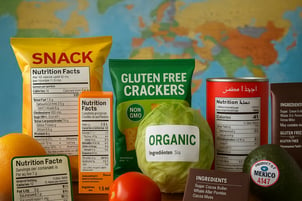A Guide to Understanding Food Safety Laws Across Different Regions
Food labelling rules vary, influenced by each country’s health priorities, culture, trade policies, and what consumers expect. For example, in the European Union, there are strict labeling laws that follow a centralized system, but in other places, things can get a bit more scattered. In the U.S., for instance, the FDA and USDA have their own separate regulations for different types of food. Meanwhile, many lower- and middle-income countries tend to stick to the Codex Alimentarius guidelines, but they tweak them based on how well they can enforce them and how informed their consumers are.
The differences in how these rules are followed come from a range of factors. There are varying perceptions about risk, like with GMOs, different ideas about nutrition, and cultural or religious considerations, such as halal or kosher requirements. On top of that, the level of regulation in the food industry plays a role. As globalization ramps up food trade, it's becoming more crucial to bring these standards in line, but that's not always easy to do.
Why Food Labelling Regulations Matter Globally
At their core, food labelling regulations are about protecting public health and ensuring consumer rights. Accurate and transparent labelling is crucial for:
-
Health & Safety: Labels are super important because they give you key info about allergens, ingredients, and nutrition. If products are poorly labelled or not labelled enough, it could lead to serious health problems, especially for folks with allergies or specific diets.
-
Consumer Transparency: Rules are in place to make sure shoppers know what they’re eating, whether it’s the calorie count or where the food comes from. This kind of transparency helps build trust between brands and their customers.
-
Preventing Misleading Claims: If we didn’t have regulations, some producers might throw around exaggerated health claims or use vague terms like “natural” or “pure,” which could really mislead consumers. Strict labelling laws help keep this kind of misleading marketing in check.
-
Harmonizing Trade and Compliance: For countries trading food internationally, having clear and accurate labels is crucial. It ensures they meet the importing country’s legal standards, which helps avoid costly border rejections.
Key Components Required on Food Labels
Even with some regional variations, a lot of countries stick to Codex Alimentarius standards, which are the international food guidelines made by the FAO and WHO. Here are some key elements that are typically considered standard requirements in most places:
Universal Label Elements
-
Product Name: The product’s name should be clear and not misleading.
-
Ingredient List: You need to list ingredients by weight, starting from the highest amount to the lowest, so it’s easy to understand what’s in it.
-
Allergens: Important allergens like milk, eggs, fish, nuts, soy, wheat, and shellfish have to be clearly marked, using bold or capital letters.
-
Nutrition Panel: In most places, it’s required to show energy (in calories or kilojoules), fat, carbs, sugar, protein, and salt/sodium either per serving or for every 100g/ml.
-
Date Marking: Label with either a “best before” or “use by” date, depending on how perishable the product is, so consumers know about its freshness and safety.
Claims and Certifications
Countries have rules for claims like 'organic,' 'gluten-free,' 'vegan,' or 'non-GMO' to stop them from being misused. For example:
-
In the EU, you need to get certified to use the 'organic' label under Regulation (EU) 2018/848.
-
In the US, the USDA Organic label makes sure that products meet federal standards.
-
For gluten-free labels, products usually have to contain less than 20ppm of gluten, according to Codex and FDA guidelines.
If brands make false claims or don’t have the right certification, they could face product recalls and legal trouble. So, it’s definitely a risky area for companies.
Country-of-Origin and Traceability
Being able to trace where food comes from and having clear labels is really important for keeping our supply chain transparent. This transparency plays a big role in food safety, handling recalls, and making sure sourcing is ethical. For instance, there's the EU Regulation No 1169/2011, which requires that meats, honey, olive oil, and other foods have clear origin labels. Also, the Codex General Standard for the Labelling of Prepackaged Foods suggests that if not stating the country of origin could confuse consumers, it should definitely be included.
Regulatory Snapshot
North America
United States (FDA)
The FDA, or the U.S. Food and Drug Administration, manages the labels on most packaged foods according to the Federal Food, Drug, and Cosmetic Act. Here are some key points:
-
There’s a Nutrition Facts panel that's mandatory, and since 2016, it’s required to show added sugars as well.
-
You also have to list common allergens, thanks to the Food Allergen Labeling and Consumer Protection Act (FALCPA).
-
Nutrients like sodium, saturated fat, and fiber come with a Daily Value (%DV) percentage.
-
Plus, if a product makes a health claim, it has to be supported by scientific evidence.
Canada (CFIA)
The Canadian Food Inspection Agency (CFIA) oversees food labelling following the Safe Food for Canadians Regulations (SFCR). Here are some key points:
-
Labels must be in both English and French.
-
Starting in 2026, foods that are high in sodium, sugars, or saturated fat will need to include front-of-pack nutrition symbols.
-
There’s also a requirement to clearly list priority allergens, including mustard, sesame, and sulfites.
Europe
European Union
The EU sticks to Regulation (EU) No 1169/2011, which standardizes food information across its member states. Here’s how it breaks down:
-
Nutritional labels are a must. They need to show energy, fat, saturates, carbs, sugars, protein, and salt.
-
Allergens have to be highlighted clearly in the ingredient list.
-
There are strict rules on nutrition and health claims, only those that the European Food Safety Authority (EFSA) approves can be used.
-
Lastly, origin labelling is required for meats, fresh produce, and unprocessed foods.
Asia-Pacific (APAC)
India (FSSAI)
In India, the Food Safety and Standards Authority (FSSAI) is in charge of food labelling, following the rules set out in the Food Safety and Standards (Labelling and Display) Regulations of 2020. Here are some key points:
-
There are now required nutrition labels on the front of food packaging that show calories, sugar, salt, and fat content.
-
They're also looking into a color-coded system for foods that are high in fat, sugar, or salt (HFSS).
-
Plus, there are special logos for vegan, organic, and fortified foods, like a green 'V' for vegan products.
Australia & New Zealand (FSANZ)
Food Standards Australia New Zealand (FSANZ) manages joint food labelling standards:
-
Nutrition Information Panel (NIP) is mandatory, along with ingredient listing and allergens.
-
Voluntary Health Star Rating (HSR) helps consumers assess nutritional quality.
-
Clear country-of-origin labelling rules under Australia’s Country of Origin Food Labelling Information Standard 2016.
Middle East
Gulf Cooperation Council (GCC), UAE, Saudi Arabia (KSA)
In the Middle East, labeling rules are managed by the Gulf Standards Organization (GSO), but countries enforce them individually. Here are some key points:
-
Labels must be in Arabic.
-
Halal certification is generally required.
-
There’s a growing focus on nutritional labels, especially in the UAE, where there's a sugar tax on sweet drinks.
-
In Saudi Arabia, they require clear energy values on labels and are working on front-of-pack nutrition labels for foods high in fat, sugar, or salt.
Regulatory Challenges in Cross-Border Labelling
Even with attempts to streamline things, food manufacturers around the world are up against several hurdles when it comes to meeting various labelling rules in different markets:
Format Inconsistencies
-
Nutrition facts, ingredient lists, and allergen information can often look different in terms of layout and positioning.
-
What counts as optional in one country might be a must-have in another. Take added sugars, for instance: it’s required in the U.S. but not in the EU.
Space Constraints vs. Multilingual Compliance
-
For regions with multiple languages, like Canada, the UAE, and India, labels need to fit two or more languages, which can be tricky on small packages.
-
This leads to a bit of a design dilemma when trying to keep everything readable while also following the rules and maintaining brand identity.
Tracking Label Versions Across SKUs and Regions
-
Companies managing a bunch of SKUs have to keep track of different label versions for each country.
-
Plus, with regulations changing so often, labels have to be updated regularly, creating quite a compliance and operational challenge.
How PLM Software Simplifies Global Labelling Compliance
For global food manufacturers working with clinics, allergens, multiple languages, and changing regulations, a PLM tool like Plevenn really tackles those tricky labelling issues. Here’s how it makes a difference:
-
Centralized Specification & Formulation Management: Plevenn allows teams to keep track of ingredient formulations, specifications, and allergen information all in one cloud-based place, making sure everything stays consistent across different labels and regions.
-
Document & Digital Asset Control: All the artwork, label templates, regulatory documents, and other assets are version-controlled and securely stored. This helps get rid of any outdated content and keeps approvals aligned globally.
-
Packaging & Labelling Module: There’s a special feature in Plevenn to compile label inputs like nutrition data, claims, origin, translations, and ensure compliance across markets, all from one platform.
-
Cross-Functional Collaboration: Teams from R&D, regulatory, packaging, and marketing can work together on a single label workspace, which really cuts down on review loops and mistakes.
Conclusion
Food labelling rules are changing as consumers' needs evolve, health standards get stricter, and global trade expands. For brands that operate internationally, being precise and adaptable is crucial.
Thanks to digital solutions like PLM softwares, teams can handle everything from formulation data and packaging inputs to regulatory paperwork all in one place. This cuts down on risks, saves time, and keeps things accurate. With this organized approach, businesses can navigate country-specific regulations without messing up their launch schedules or risking compliance issues.
To succeed in global markets, it’s all about staying up-to-date, coordinated, and compliant. Clear labelling can really set you apart from the competition.
Tags:
Aug 13, 2025 5:34:39 PM






